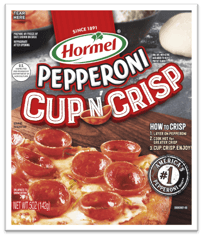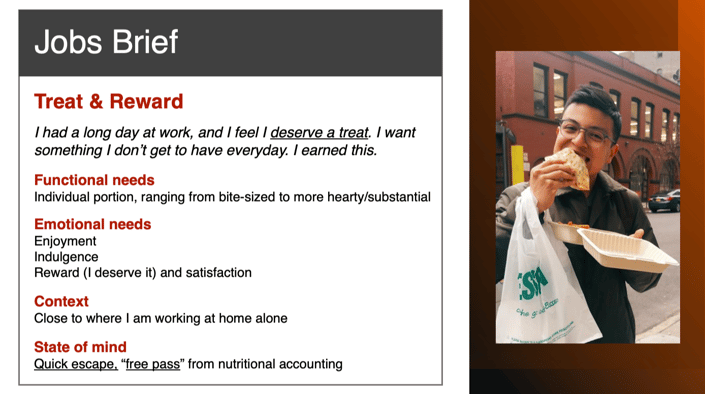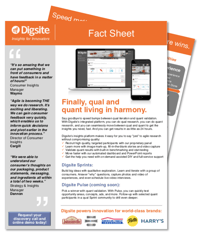Many of today’s successful teams are applying a Jobs-to-be-Done (JTBD) framework to redefine product categories and identify new opportunity areas for their brand. Among those success stories is Hormel Foods’ consumer insights team.
During our 2021 Quirk’s Chicago event session, Hormel joined us to tell the story of how they adopted and implemented JTBD thinking to get necessary insights and drive growth. You can watch a recording of the session here.
Does your team currently use the JTBD approach in your work? Are you considering it? Keep reading to learn how Hormel Foods integrated JTBD into their innovation pipeline.
Session Speakers

The Job
A Job is really a problem or an opportunity that someone is trying to solve. People hire products, brands and services to accomplish those Jobs and get things done. When we talk about a Job, it's more of a holistic view of what the individual is looking for. It's more than just a functional aspect, it's the emotional and the social side too.
Take a skateboard for example. The functional aspect is that it's a board with wheels, and it rolls down the street to get you from one place to another. But when you think about skateboarding, the emotional and social aspects (feeling of freedom or the fun you have with friends) may be even more important.
The Components of the Job
When you think about consumer choice in the Jobs framework, rather than looking independently at what the need is, you need to holistically look at the person's behavior or experience. Examine the process the consumer is going through and the job that the product does within a specific context.
A Job has four components: the person you want to help, the progress they want to make, the circumstances they’re in and the obstacles they need to overcome.
- The person: Imagine that you’re a busy parent on a weeknight.
- The progress: You want to make a real dinner that everyone will love.
- The circumstance: You’re shopping on a budget, perhaps a week or two away from payday or you’ve been eating out a lot and want to pull back on spending.
- The obstacles: What makes it challenging is that you have picky kids and you’re exhausted from work, or maybe you’re not excited to come home and cook. Perhaps you have limited time in your day from when you get off work to when you want to have dinner on the table.
In other words, a person is making some kind of progress in their day. Within the circumstances of that specific moment, they typically have to overcome some kind of obstacle to achieve that goal or meet that need. The magic in JTBD is using human interaction to understand functional, emotional and social attributes.
JTBD isn’t revolutionary by any means, but it is an evolution. So much emphasis has been placed on big data – whether it’s purchase data, customer satisfaction or social listening – but it just shows you the what and not the why. JTBD helps you understand the root cause of consumer behavior, their decisions, their choices, and ultimately, what opportunities your brand can present.
JTBD + Hormel New Product Launches
Authentic Mexican sauces for street tacos aren’t typically associated with the Hormel foods brand. But Herdez is one of the many brands in Hormel’s portfolio. So, let’s break down the Job that this product is addressing:
The progress: They want to spice up their routine (literally) by bringing some excitement to the ordinary. Maybe they want to incorporate some authentic Mexican restaurant flavor into their cooking.
Another product that Hormel developed to make the ordinary more
exciting is the Cup N’ Crisp pepperoni.
The person: A parent whipping up homemade pizza for family night.
The progress: They want to bring some fun into the kitchen and get their kids involved in the cooking process.
Hormel’s Innovation Process
So where do Jobs fit in the process? Through Hormel’s innovation process, it starts at the front end. To build out concepts, you need to define some sort of strategy. Start by trying to understand the consumer, then create some concepts, test those concepts with consumers and then build out the pipeline. Once you have your pipeline built out, you move into the back-end process of making the product and selling it.
A lot of companies have a very similar process that starts with a well-written Job statement that’s easy for anyone to understand. It carries out throughout the entire process, from ideation, to concept creation, to manufacturing to sales.
Take for example “Treating and Rewarding”:
Keys to Hormel’s Success
1. Pushing boundaries on innovation territories.
When you start an innovation project, you need to take a hard look at where you should be innovating. In the “treating and rewarding” example above, it would have been assumed that millennials are health-obsessed. But, when you do the actual Jobs work, that's when you find out there's a huge opportunity in the area of indulgence. Sometimes, folks just really want bacon.
2. Narrowing concept ideas.
Most people have been in that room where the walls are covered in post-it notes. With all the ideas displayed, it’s important to focus in and cut the fat. Bill from the marketing department might really like pretzels, but you need to stick to the process and move forward with ideas that best address the obstacles of a Job.
3. Ensuring the product continues to focus on consumer needs.
JTBD can truly anchor the whole process from beginning to end. As you get to the back end of development, it’s extremely important to make sure you’re creating products that meet consumer needs. Hormel has actually stopped some products from launching after they strayed too far away from the consumer need.
4. Performing in-depth qualitative consumer testing.
Qualitative consumer research is the driving force behind identifying and documenting relevant JTBD. Hormel uses Digsite Sprints to collect artifacts like video experiences to determine what consumers are trying to do or make happen, what obstacles are in their way and what workarounds they’ve put in place. Discussions, videos and photos let allow your consumers to bring you into their lives, homes, and their daily activities like shopping to share their experiences.
Read about some common JTBD challenges and how to overcome them here.
Prioritizing Jobs is a process.
Jobs-to-be-done has become a very successful framework because it's easy to understand and has proven to be an effective model in implementing innovation. Plus, it doesn’t require a large segmentation study to get there. In a rapidly changing market, we need to refresh our thinking on Jobs more often to shorten the timeline of any given study. Innovation can be far more predictable—and profitable—if you start by identifying Jobs that customers are struggling to get done. Without that perspective, your process could miss major opportunities for innovation.

Want to learn how the Digsite platform can help you uncover and validate jobs more effectively without the guesswork?
Check out our fact sheet to learn more about Digsite's capabilities.




